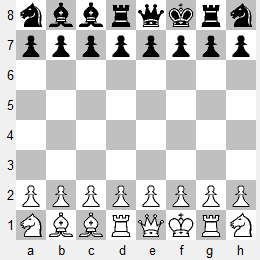Petrarlsen 3/2/2018 03:31 • In one of the Carlsen - Nakamura game, the two players castled on move one, and I rather think that every game played with this position between top GMs would follow the same course; this feels more like a farce than like the beginning of a serious game.
The game reference is to the recent match, 2018 Carlsen - Nakamura (February 2018). The commenter continued,
What can be the meaning of castling if the players castle on the first move and wouldn't even consider playing any other move?
Ignoring the arrogant assumption about knowing what the players considered or didn't consider, let's look at the position. The PGN is available via my '2018 Carlsen - Nakamura' post. It turns out that the position was used in games 11 and 12 of the match, when both games were drawn.

SP324 NBBRQKRN
In game 11, with Nakamura as White, the players continued 1.O-O O-O. With Carlsen as White, the first moves were 1.c4 O-O 2.O-O. Carlsen at least tried 1.c4, but then castled on his next move.
Looking at the position more carefully, what are the logistics behind castling O-O-O? Taking White as the example, we have to move the dark-squared Bishop and the Queen to enable O-O-O. Both moves can be prepared by d2-d4 (or d2-d3), after which there is a further question of where to place the Bishop or Queen when it moves. Neither piece has an obvious developing square, and the Bc1 is perhaps better on the long diagonal. So it takes at least four moves to play O-O-O, after which there is no particular advantage in the resulting position. The move O-O, on the other hand, looks natural -- the King is a little safer and the Rooks are connected. Isn't that what castling is supposed to achieve?
Rather than being 'more like a farce than like the beginning of a serious game', the move O-O is the first idea in what promises to be a long, tight struggle. It also adheres to the principle of playing the obvious moves first. As for the other start positions where O-O is possible on the first move, I once counted these positions in Introduction to Chess960 Geometry (March 2009, on my main blog):-
There are 90 start positions where the players can castle O-O on the first move. [...] There are 72 positions where the players can castle O-O-O on the first move.
I am sure that not all of these 90 positions are as straightforward as SP324. As a final thought, in a post titled On a Losing Streak (May 2015), I wrote,
After the game, my opponent said, 'I have found from past personal experience, castling on the first move makes for a very difficult game!' I could hardly disagree with him, especially when it is followed by a dubious gambit.
While that opponent might have exaggerated his personal experience, it is a more useful general rule than to claim that a player should always castle on the first move whenever possible. Another general rule is that castling considerations are more complicated in chess960 than in traditional chess, even if specific start positions might be less complicated.

No comments:
Post a Comment